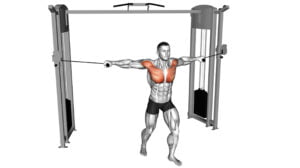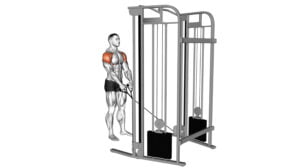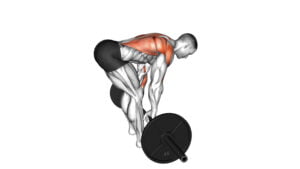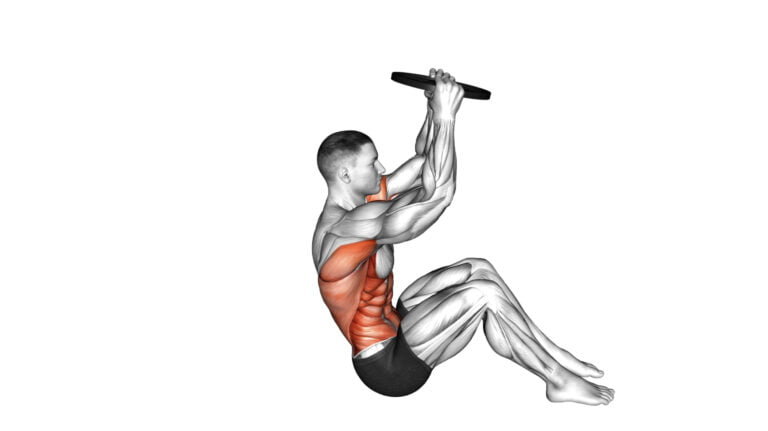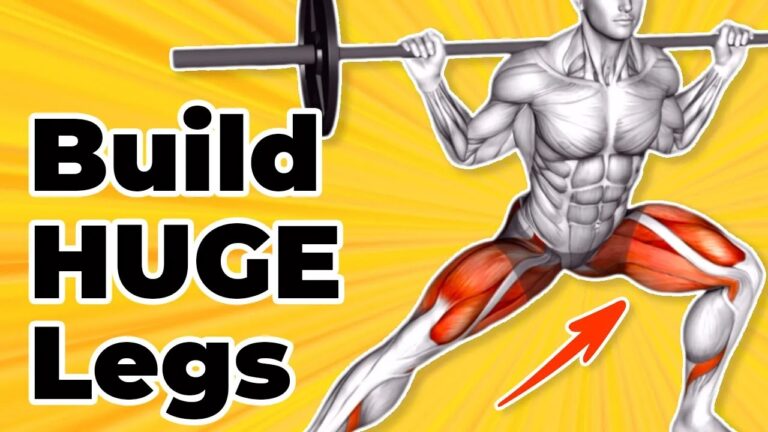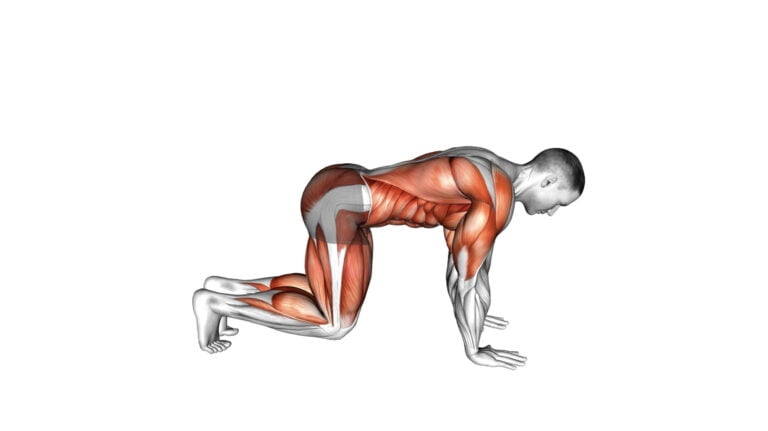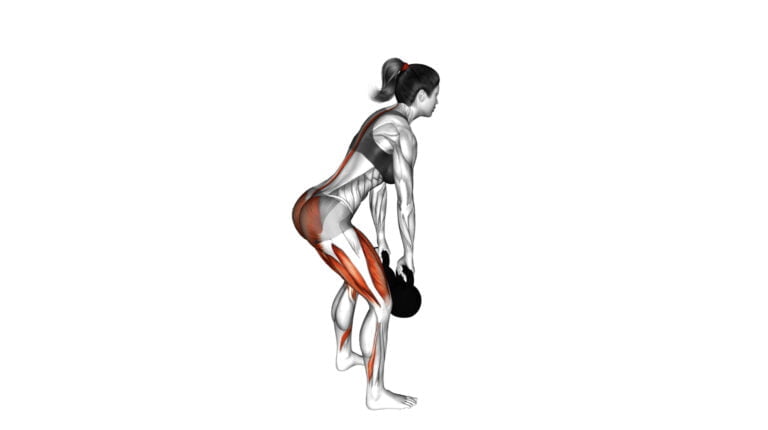10 Lat Exercises On Cables For A Strong And Sculpted Back

Mastering the art of a strong and sculpted back is often met with images of heavy deadlifts and barbell rows, but there’s an unsung hero in your gym that can be just as effective—cable machines.
With years of strength training experience under my belt, I’ve seen firsthand how lat exercises on cables can revolutionize back workouts. What many don’t realize is the versatility these machines offer; they’re not merely supporting acts but key players in creating powerful lats and a well-defined V-taper.
Cables allow for a constant tension throughout exercises that free weights simply can’t match, ensuring that every part of the movement counts toward building those essential back muscles—from shoulders to waistline.
This article will shed light on ten specially chosen lat exercises on cables, each designed to maximize your muscle growth while minimizing injury risks. And remember: it’s not just about adding mass; it’s about enhancing functional strength too.

Ready to redefine your back routine? Let’s dive in!
Key Takeaways
- Cable machines provide continuous tension on back muscles, improving both strength and muscle definition.
- Different grips and attachments can be used to target specific areas of the latissimus dorsi from various angles for better symmetry and development.
- A variety of cable lat exercises ensures a comprehensive workout, hitting all parts of the back for balanced growth.
- Proper form, controlled range of motion, and varying grip positions are essential for effective back training with cables.
- For a well – rounded routine, it’s important to include vertical and horizontal movements as well as alternate grips during cable workouts.
Benefits of Cable Back Exercises
Cable back exercises offer the benefit of training in a non-fixed range of motion, allowing for more flexibility and muscle engagement. They also work the back muscles from all angles, helping to develop a strong and sculpted physique.
Plus, they are easy to set up, making them accessible for both beginners and experienced lifters alike.
Train in a non-fixed range of motion
Embrace the freedom of movement that comes with non-fixed range of motion exercises. Using cables to work your lats allows you to engage muscles dynamically, as opposed to the rigid paths set by machines.
This way, you challenge your latissimus dorsi along with synergistic muscles like biceps, rear delts, and rotator cuff muscles in a more natural and functional pattern of movement.
Push your back workouts beyond the limits with this training technique that ensures constant tension on every inch of the muscle’s journey. Whether pulling down or stretching out during those high-intensity sets, each repetition is an opportunity for enhanced muscle activation and heightened hypertrophy across your entire back landscape – from shoulder blades to lower back – paving the way for strength gains you can both see and feel.

Work back muscles from all angles
Harnessing the versatility of cables in your workout regime allows for a dynamic approach that hits every part of your back. The range of motion and adjustability mean you can perform wide-grip, narrow-grip, and reverse-grip movements to challenge muscles like the lats, rhomboids, and rear deltoids from multiple angles.
This kind of targeted training leads to better muscle balance and symmetry throughout your entire back.
Utilize various grips such as palms-down or supinated positions with attachments like V-bars or mag grips to specifically isolate different areas. Each exercise engages the muscles differently—whether it’s through adduction as you draw your elbows towards your ribs during a lat pulldown or extension when stretching arms out in a straight-arm pullover.
Your back routine on cables will not only strengthen but also sculpt those key muscle groups for an impressive upper body that’s strong from every angle.
Easy to set up
After exploring how cable exercises allow you to work back muscles from various angles, it’s worth noting the simplicity of their setup. Cable machines provide a straightforward way for anyone looking to enhance their back workouts.
You don’t need an array of heavy barbells or a rack full of weight plates; with just one cable station, you can perform a multitude of lat exercises designed for muscle-building and strength conditioning.
These setups are user-friendly and often come with adjustable features that cater to different heights and strengths, making them suitable for both beginners and experienced lifters alike.
Getting started is as easy as selecting the desired weight, attaching your preferred handle or bar, and adjusting the pulley position. Within moments, you’re ready to begin your exercise routine focusing on lats, trapezius muscles, rhomboids, teres major—and all without extensive preparations or equipment changes.
10 Best Lat Exercises on Cables
Get ready to sculpt and strengthen your back with these 10 effective lat exercises on cables. These movements target the lats from different angles, providing a well-rounded workout for a strong and toned back.
1. Cable Kneeling One Arm Lat Pulldown
The Cable Kneeling One Arm Lat Pulldown directly targets the latissimus dorsi muscles, helping to enhance overall back strength and muscle definition. This exercise involves pulling the cable down toward the body while kneeling, using one arm at a time and engaging the core for stability and balance.
By incorporating this effective workout into your routine, you can achieve a well-defined and strong back alongside improved core control.
2. Cable Lat Pulldown Full Range Of Motion
The Cable Lat Pulldown Full Range Of Motion is a vital exercise for anyone aiming to strengthen and sculpt their back. With this exercise, you can effectively target the latissimus dorsi muscles by engaging in a complete range of motion.
This not only builds strength but also helps in achieving definition in the back muscles. It’s crucial to maintain proper form throughout the movement and incorporate different grips or handles to add variety and challenge your muscles effectively.
Performing the Cable Lat Pulldown Full Range of Motion with consistency can significantly contribute to overall back strength and development, making it an essential addition to any well-rounded workout routine focused on building a strong and sculpted back.
3. Cable Lateral Pulldown with Mag Grip
The cable lateral pulldown with mag grip targets the latissimus dorsi muscles. The mag grip attachment allows for a neutral grip position, reducing strain on the wrists and elbows.
This exercise is versatile and can be adjusted to target different parts of the back, offering various rep ranges and weights. Proper form and technique are crucial for achieving a well-defined and muscular back.
4. Cable Lateral Pulldown with V-bar
How to perform the Cable Lateral Pulldown with V-bar exercise? The V-bar attachment provides a neutral grip, reducing strain on the wrists and elbows while effectively targeting the latissimus dorsi muscles. Proper form is crucial to ensure that the lats are engaged and to prevent injury when performing this exercise.
The intensity can be adjusted according to one’s fitness level, making it suitable for both beginners and advanced lifters.
Adjusting resistance and focusing on technique can help sculpt and strengthen back muscles, leading to a more balanced physique with defined lats.
5. Cable Neutral Grip Lat Pulldown
Transitioning from the V-bar to the Cable Neutral Grip Lat Pulldown provides a dynamic shift in targeted muscle engagement. This exercise primarily targets the latissimus dorsi muscles, working them from a different angle than traditional pulldowns.
The cable machine facilitates a smooth and continuous range of motion, allowing for effective muscle contraction throughout the exercise.
Utilizing different handle attachments can enhance variety and intensity, providing an opportunity to challenge your back muscles in new ways. By incorporating Cable Neutral Grip Lat Pulldowns into your routine, you can effectively strengthen and sculpt your back while enjoying the benefits of varied grip positions and continuous resistance.
6. Cable One Arm Pulldown
The Cable One Arm Pulldown is a versatile lat exercise that helps target and strengthen the latissimus dorsi (lats) to sculpt and define your back muscles. This movement involves pulling the cable down and across the body, engaging the lats effectively.
Using different grips and attachments allows for variation in targeting specific areas of the back, making this exercise adaptable to different fitness levels and goals.
It’s worth noting that this exercise offers a dynamic way to engage your back muscles while also promoting strength and definition. Incorporating it into your workout routine can contribute significantly to achieving a sculpted back with improved muscle tone.
7. Cable Parallel Grip Lat Pulldown on Floor
Perform the Cable Parallel Grip Lat Pulldown on the floor using a cable machine with a parallel grip handle. While kneeling, engage the lat muscles by pulling the handle down towards your chest in a palms-down position.
This exercise allows for full range of motion and can be customized with varying resistance levels, contributing to strength and muscle definition in your back.
8. Cable Standing Lat Pulldown
Engage your latissimus dorsi muscles with the Cable Standing Lat Pulldown. Take a strong stance and pull the cable down while keeping your core engaged for stability. Adjust resistance levels by changing the weight on the cable machine to challenge yourself as you build a powerful back.
Use proper form and technique to avoid injury, maximize effectiveness, and achieve balanced muscle development in your back. Focusing on this exercise can be beneficial when incorporated into a comprehensive workout routine that targets all areas of your back musculature.
9. Cable Single Arm Side Straight Arm Lat Pulldown
The Cable Single Arm Side Straight Arm Lat Pulldown emphasizes the latissimus dorsi muscle, contributing to a sculpted and defined back. Using a cable machine, pull the handle down to the side while maintaining a stable torso and straight arm.
This exercise enhances overall back strength and posture by reinforcing the muscles that support the spine. It targets the muscles on the side of the back, promoting a well-defined appearance and enhancing postural integrity.
Proper form is crucial when performing this exercise to minimize injury risk and optimize its benefits. Incorporating this movement into an inclusive back workout routine along with other cable lat exercises can help achieve robust, sculpted back musculature that supports overall fitness goals.
10. Cable Twin Handle Parallel Grip Lat Pulldown
Engage your lat muscles with the Cable Twin Handle Parallel Grip Lat Pulldown. Pull the cable bar towards your chest using a parallel grip, effectively targeting your lats from a different angle than traditional lat pulldowns.
This exercise can enhance back strength and muscle definition when executed with proper form and control, while also engaging the biceps and shoulders for a comprehensive upper body workout.
How to Create a Sample Back Workout with Cables
To create a sample back workout with cables, choose 3-4 exercises and aim for 3 sets of 10-12 reps. Alternate between horizontal and vertical movements to target different areas of the back for a well-rounded routine.
Choose 3-4 exercises
Select 3-4 exercises that target different areas of your back to ensure a comprehensive workout. Incorporate movements such as cable kneeling one arm lat pulldown, cable lateral pulldown with mag grip, and cable standing lat pulldown to engage your lats, mid-back, and lower back.
By choosing a variety of exercises, you can effectively strengthen and sculpt your entire back region for balanced muscle development.
Opt for exercises like cable neutral grip lat pulldown or cable one arm pulldown to work on specific areas within the back muscles for improved definition and strength. Including these exercises in your routine will help you achieve a well-rounded back workout that targets various muscle groups within the back region.

Aim for 3 sets of 10-12 reps
Complete each exercise for 3 sets, aiming to do 10-12 reps in each set. This rep range helps build both strength and muscle endurance in your back muscles. Maintain good form throughout the entire set to maximize the benefits of each repetition.
For a well-rounded back workout with cables, aim for 3 sets of 10-12 reps per exercise. Following this guideline ensures that you challenge your muscles adequately while allowing for sufficient recovery between sets.
Alternate between horizontal and vertical movements
Mixing up your back training with a blend of horizontal and vertical movements helps target different muscle groups comprehensively. Begin with vertical exercises like Cable Lat Pulldown Full Range Of Motion to engage upper back muscles, then transition to horizontal movements such as Cable Kneeling One Arm Lat Pulldown, which effectively targets the lower back.
This alternating approach not only challenges stability but also ensures a well-rounded workout for all parts of the back.
Incorporating standing and kneeling exercises like Cable Standing Lat Pulldown and Cable Kneeling One Arm Lat Pulldown not only diversifies your routine but also activates core muscles, enhancing overall strength and stability during back workouts.
Tips for Effective Cable Back Workouts
Maintain proper form and focus on a controlled range of motion for effective cable back workouts. Use a variety of grips and handles, and incorporate other back exercises for a well-rounded routine to maximize your results.

Maintain proper form
Engage the core and keep your back straight to maintain proper form during cable back exercises. Pull your shoulders down and back, ensuring a controlled range of motion in each movement.
Adjust the cable machine to the appropriate height and weight for effective muscle engagement without compromising form. Gradually increase resistance as strength improves, focusing on feeling the lats working throughout each exercise.
Now, let’s explore how to create a sample back workout with cables to maximize your training routine.
Focus on a controlled range of motion
Maintaining a controlled range of motion while performing cable back exercises is crucial for effectively targeting and strengthening the lat muscles. By focusing on a deliberate and steady movement, you engage the targeted muscles throughout the exercise, promoting better muscle engagement and development.
This approach not only minimizes strain on other muscle groups but also ensures that your back receives consistent tension throughout each repetition, leading to improved results over time.
Doing cable back workouts with a controlled range of motion helps prevent injury and enhances workout effectiveness by allowing for smoother execution of movements. When you concentrate on controlling each phase of the exercise, you reduce the risk of straining or injuring other muscle groups while optimizing the activation of your lats.

Use a variety of grips and handles
To complement a controlled range of motion, incorporating a variety of grips and handles during cable back exercises is essential. Utilizing different grips such as wide, narrow, overhand, underhand, or neutral grip can target various muscles in the back, promoting muscle development and overall strength.
Experimenting with different handles like straight bars, v-bars, D-handles or rope attachments allows for diverse movements and angles that challenge the back muscles from multiple perspectives.
By regularly switching up grips and handles in your cable workouts, you can prevent plateaus in training while also fostering balanced muscle development throughout the entire back region.
Incorporate other back exercises for a well-rounded routine
To ensure a well-rounded routine, it’s important to include other back exercises alongside cable lat workouts. Incorporating movements such as rows, deadlifts, and pull-ups can effectively target the upper, middle, and lower back muscles.
By diversifying your routine, you can prevent muscle imbalances and reduce the risk of injury during your cable back workouts.
Adding variety in your exercises not only strengthens different areas of the back but also improves overall stability and performance in other activities. This approach helps to prevent plateaus and ensures continued progress in strength training.
Be consistent and progressive in your training.
Incorporate other back exercises for a well-rounded routine and maintain consistency in your training regimen to see significant progress. Consistency in training not only enhances strength but also leads to better muscle endurance and overall fitness improvements.
Additionally, focusing on progression through gradually increasing weights or repetitions ensures continuous development and prevents plateauing. Challenging oneself with incremental changes is vital for sustained growth and improved performance over time.
To achieve optimal results, it’s important to stay committed to your workout schedule while progressively challenging yourself with manageable increments in intensity or difficulty.
Conclusion

Incorporate these 10 effective lat exercises on cables into your back workout for a stronger and sculpted back. The practicality and efficiency of cable exercises make them easy to implement for achieving desired results.
How will you apply these strategies to maximize the impact on your back muscles? Emphasize the importance of consistent training and progressive overload for significant improvements in strength and muscle development.
Explore additional resources or seek guidance from a fitness professional to further enhance your back training routine. Take charge of your fitness journey with dedicated efforts towards building a strong and well-defined back.
FAQs
1. What muscles do lat exercises on cables target?
Lat exercises primarily work the muscles of your back including the latissimus dorsi, teres major and minor, rhomboid major, and can also engage the posterior deltoids for a strong and sculpted look.
2. Why should I include cable workouts for my lats?
Including cable workouts in your regimen promotes strength in key back muscles, aids shoulder joint health by training scapula retraction, supports better posture, and can enhance overall upper body power.
3. Are there variations of lat exercises that also involve other muscle groups?
Absolutely! Many compound exercises like pull-downs or rows on cables not only target the lats but also activate supporting muscle groups such as biceps, triceps, pecs, and even glutes when performed with proper techniques.
4. Can beginners perform cable lat exercises safely?
Yes, with guidance from personal trainers or instructional content focusing on correct form and starting with light weights to protect from injury while conditioning the shoulderblades’ movement range effectively.
5. How does working out my lats help my performance in other activities?
A stable and powerful back achieved through isolation exercise of the lats contributes to improved performance in sports that require abduction of humerus or medial rotation like swimming or throwing; it’s essential for runners too!
6. What equipment will I need to do these 10 lat exercises?
You’ll only need access to universal gym equipment featuring a cable machine which is versatile enough allowing you to perform various movements targeting your lats efficiently within different planes of motion.

Author
Years ago, the spark of my life’s passion ignited in my mind the moment I stepped into the local gym for the first time. The inaugural bead of perspiration, the initial endeavor, the very first surge of endorphins, and a sense of pride that washed over me post-workout marked the beginning of my deep-seated interest in strength sports, fitness, and sports nutrition. This very curiosity blossomed rapidly into a profound fascination, propelling me to earn a Master’s degree in Physical Education from the Academy of Physical Education in Krakow, followed by a Sports Manager diploma from the Jagiellonian University. My journey of growth led me to gain more specialized qualifications, such as being a certified personal trainer with a focus on sports dietetics, a lifeguard, and an instructor for wellness and corrective gymnastics. Theoretical knowledge paired seamlessly with practical experience, reinforcing my belief that the transformation of individuals under my guidance was also a reflection of my personal growth. This belief holds true even today. Each day, I strive to push the boundaries and explore new realms. These realms gently elevate me to greater heights. The unique combination of passion for my field and the continuous quest for growth fuels my drive to break new ground.

